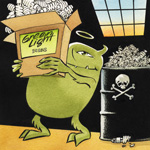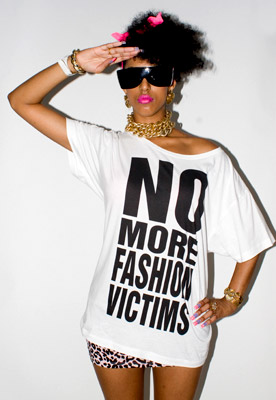Below is my tweet along for Compostmodern09, which took place on Sat. Feb 21st 09. This event was greatly inspiring, and I will be writing a post soon on the over all themes of the conference and where the convergence into sustainable fashion design comes into play. Stay tuned for that post (and some images as well).
· excited to be at #cm09 8:19 AM Feb 21st
· #cm09 only 5000 days left. take it as fact. 9:55 AM Feb 21st
· #cm09 Allan Chochinov ten rules applicable to fashion design. 10:23 AM Feb 21st
· Michel Gelobler: design through the lens of soul and policy coming up, #cm09 10:26 AM Feb 21st
· wonderment being made plain/plain being made wonderment cm#09 10:28 AM Feb 21st
· Michel Gelobler certainty/worry/sorrow/hope #cm09 10:30 AM Feb 21st
· need to bend the Al Gore curve #cm09 10:32 AM Feb 21st
· Michel Gelobter: what we have, what we are using, need to establish equilibrium looking to connect product to solution. #cm09 10:40 AM Feb 21st
· #cm09 we own the solution not the problem, Michel Gelobter 10:43 AM Feb 21st
· Michel Gelobter #cm09 further mention of the design acccord http://tinyurl.com/b5yzl4 10:47 AM Feb 21st
· Saul Griffith howtoons http://www.howtoons.com/ #cm09 10:52 AM Feb 21st
· Saul Griffith: 2008, the year of ‘peak waste’ #cm09 11:03 AM Feb 21st
· Saul Griffith: need to re-design everything. make it small, fish shaped,slow. need a new soundtrack, font, aesthetic. need a bob dylan.#cm09 11:14 AM Feb 21st
· Saul Griffith: we need an heirloom culture #cm09 11:17 AM Feb 21st
· Saul Griffith: I’m an earth fucker and so are you, #cm09 11:19 AM Feb 21st
· Saul Griffith: http://www.wattzon.com/ #cm09 11:20 AM Feb 21st
· Saul Griffith: soon to be born child going to kick ninja ass #cm09 11:23 AM Feb 21st
· Saul Griffith: the planet is the new design client. #cm09 11:25 AM Feb 21st
· HR + PR does not equal CSR 11:55 AM Feb 21st
· Emily Pilloton #cm09 1. what>how (sustainability=human+environment) 1:59 PM Feb 21st
· Emily Pilloton #cm09 2. the other 90% is next door (local+global) 2:00 PM Feb 21st
· Emily Pilloton #cm09 3. always bring pom-poms (and a picket signs) 2:00 PM Feb 21st
· Emily Pilloton #cm09 4. scalable systems, not stuff (take the product out of product design) 2:01 PM Feb 21st
· Emily Pilloton #cm09 5. 2 (thousand) heads are better than one (the more the merrier) 2:02 PM Feb 21st
· Emily Pilloton #cm09 6. more cattle, less hat (stop talking and just do it) 2:03 PM Feb 21st
· whats the opportunity for graphic design, asks Makower..needs to play a bigger role. 2:05 PM Feb 21st
· Emily Pilloton #cm09 started project H with 400$ in her bank 2:08 PM Feb 21st
· take the poll http://tinyurl.com/coebq5 2:10 PM Feb 21st
· Watching Pam Dorr short film “Housing Hope” 2:15 PM Feb 21st
· John Bielenberg and Pam Dorr #cm09 spoke on Project M, and some amazing housing projects. 2:17 PM Feb 21st
· John Bielenberg wants you to think “wrong” so you can find solutions. Inspired by Sambo rural studios and a beautiful mind. 2:19 PM Feb 21st
· John Bielenberg #cm09, breakthroughs happen in your late 20’s-he is inspired by grad/students. 2:22 PM Feb 21st
· #cm09 project M: think wrong http://www.projectmlab.com/ 2:23 PM Feb 21st
· #cm09 project H http://www.projecthdesign.com/ 2:25 PM Feb 21st
· all speakers at #cm09 stress the importance of serendipity in the process 2:30 PM Feb 21st
· Dawn Danby #cm09 takes an interdisciplinary perspective on responsible design 2:38 PM Feb 21st
· Dawn Danby #cm09 concerned with the small size of sustainable design social network 2:41 PM Feb 21st
· Dawn Danby #cm09 asks “are we not educating our designers correctly?” this is my research question (fashion designers) 2:45 PM Feb 21st
· Dawn Danby #cm09 “1. be cool w/ paradox 2. learn the local language 3. reconsider work worth doing 4. YOUR CLIENT IS THE PLANET” 2:46 PM Feb 21st
· Dawn Danby #cm09 talking: sustainability is not a communist plot…semantics are crucial here. **YES!** 2:54 PM Feb 21st
· Dawn Danby #cm09 designers are looking for direction-but they still need to understand the numbers in product lifecycle analysis 3:01 PM Feb 21st
· Dawn Danby-if your client is the planet…then it’s on you to figure out how to solve the problems that weve got and how to pay for it 3:03 PM Feb 21st
· Dawn Danby #cm09 “we need to get rid of our specialness” and open it up to others, interdisciplinary partnerships 3:04 PM Feb 21st
· Nathan Shedroff #cm09 is about to tell us what we can do Monday morning, when we wake up at work with all of this. 3:08 PM Feb 21st
· Nathan Shedroff #cm09 conservative = conservation start the ‘conservative’ movement with the actual definition 3:15 PM Feb 21st
· Nathan Shedroff #cm09 don’t use green… use blue… it comes off more effective in business (without being too ‘environmental’) 3:17 PM Feb 21st
· Nathan Shedroff #cm09 OH… and use the work capital *this business advice is awesome* 3:18 PM Feb 21st
· Nathan Shedroff #cm09 use some sustainable frameworks: 1. lifecycle analysis 3:19 PM Feb 21st
· 2. natural capitalism (eco- efficiency).. 3:20 PM Feb 21st
· 3. cradle to cradle 3:20 PM Feb 21st
· 4. “natural step” (trademarked) 3:21 PM Feb 21st
· 5. biomimicry 3:21 PM Feb 21st
· (the point here is that these frameworks are all incomplete…they do not cover social, financial and environmental) 3:22 PM Feb 21st
· 6. Datschefski’s “Total Beauty” 3:23 PM Feb 21st
· 7. social return on investment (SROI)*very difficult to quantify* 3:24 PM Feb 21st
· 8. (last one) sustainability helix 3:24 PM Feb 21st
· Nathan Shedroff #cm09 wants you to bring the frameworks together for a good place to start..overlap them to cover all ground 3:25 PM Feb 21st
· Nathan Shedroff #cm09 wants you to design for use be the ‘apple’ and lead the way the challenge is on your compeditor will do it if you dont 3:27 PM Feb 21st
· Nathan Shedroff #cm09 wants you to design for dematerialization (all the way back) the whole lifecycle 3:29 PM Feb 21st
· Nathan Shedroff #cm09 wants you to think about material substitution. **in the context of fibre (textiles) diversify and substitute** 3:31 PM Feb 21st
· Nathan Shedroff #cm09 wants you to think local, to decrease transport. not always a good idea though. 3:32 PM Feb 21st
· transmaterialization, Nathan Shedroff #cm09, and informationalization, are more sustainable (still have impact) 3:33 PM Feb 21st
· Nathan Shedroff #cm09: next, design for durability (did i miss one? oops) 3:35 PM Feb 21st
· design with multifuction in mind, design for reuse: Nathan Shedroff #cm09 3:36 PM Feb 21st
· design for disassembly (Rickshaw zero bag example) http://www.rickshawbags.com/# 3:38 PM Feb 21st
· Nathan Shedroff #cm09: redesign the system (Curitiba, Brazil, example) 3:39 PM Feb 21st
· Nathan Shedroff #cm09 wants us to find new models, economic models suck (ex. GDP and GPI measurements) 3:41 PM Feb 21st
· Nathan Shedroff #cm09 said DONT USE PVC!!!!!! YES!!!! http://tinyurl.com/bftk4d *thank you!!* 3:42 PM Feb 21st
· How is this a debate, again? why are these shoes being sold as “sustainable” http://tinyurl.com/b4tnaf I wish i new more about PVC 3:46 PM Feb 21st
· Joel Makower asks about green marketing #cm09 3:47 PM Feb 21st
· #cm09 Joel Makower wants gree to equal better. work around the dogma. remember the business case, here. 3:51 PM Feb 21st
· #cm09 question asked “the planet is your client” is an internal conversation? Ans. sometimes. sometimes we have to talk around the subject. 3:55 PM Feb 21st
· Joel Makower #cm09 stories through design can/should/will integrate head and heart in the discussion 4:02 PM Feb 21st
· AIGA #cm09 http://sustainability.aiga…. 4:04 PM Feb 21st



